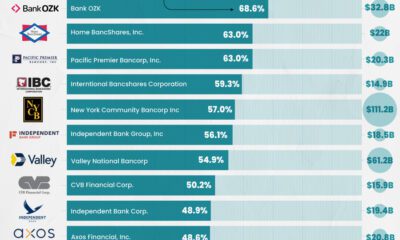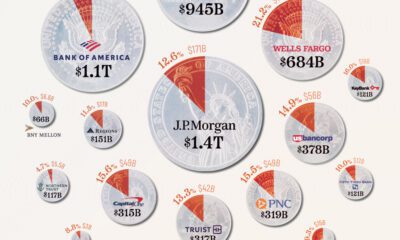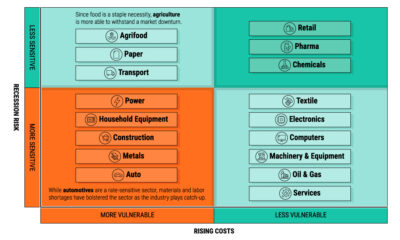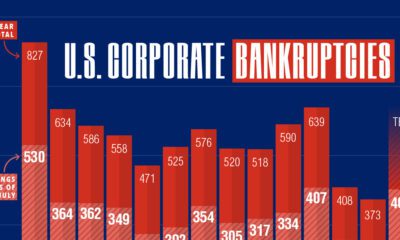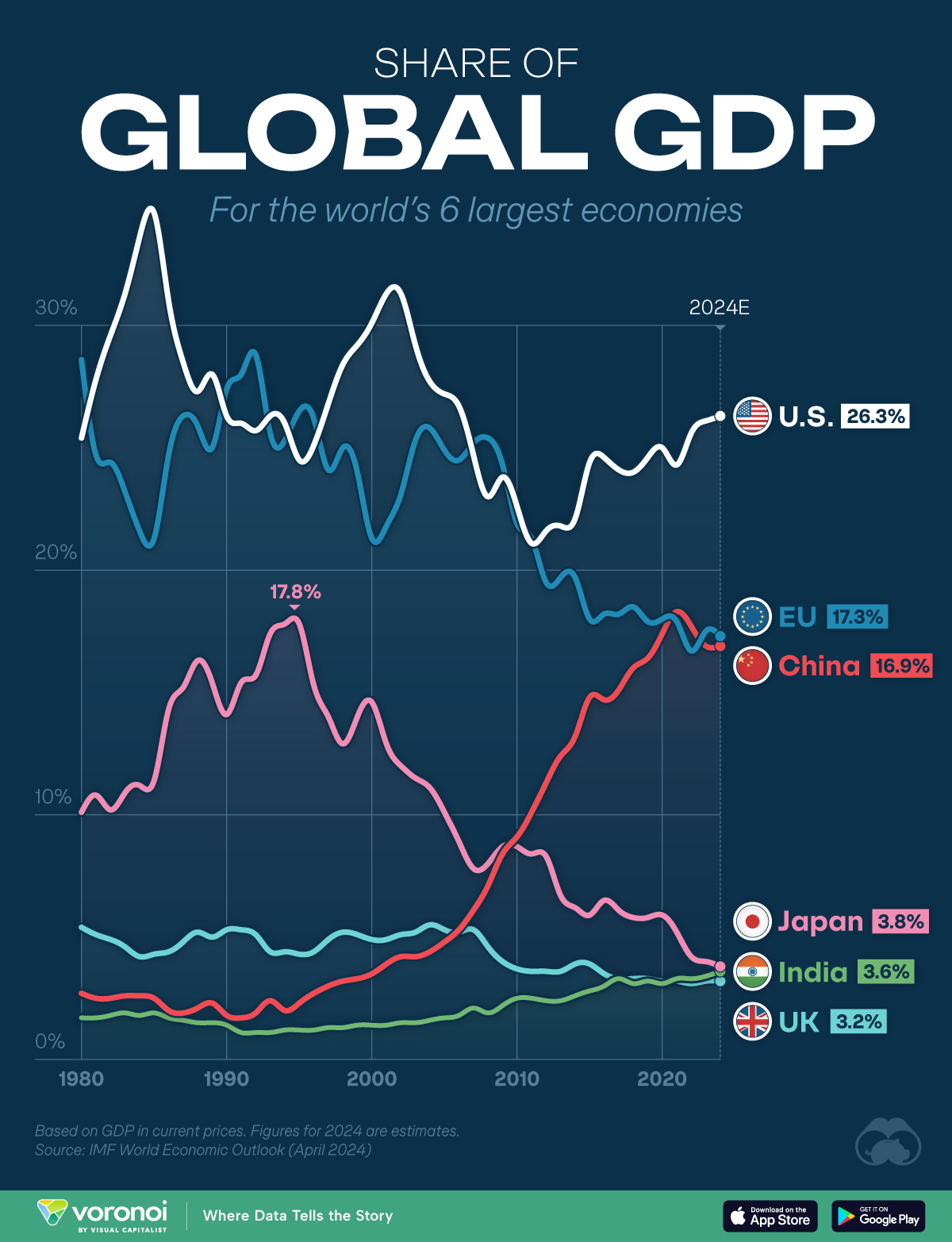Markets
Visualizing 1 Billion Square Feet of Empty Office Space
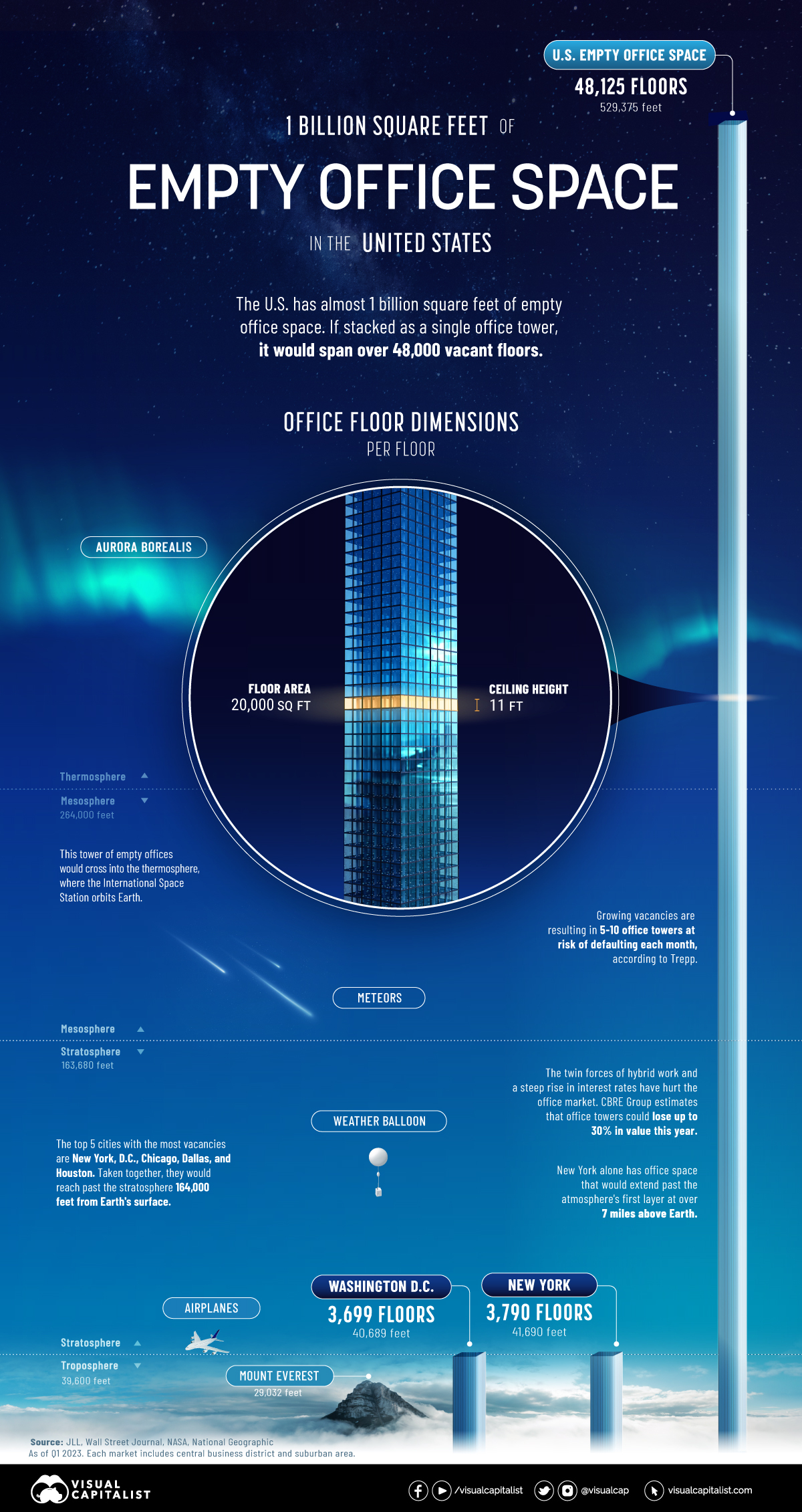
1 Billion Square Feet of Empty Office Space
In April, one of America’s largest office owners, Brookfield, defaulted on a $161 million loan.
The loan, covering 12 office buildings, was mainly concentrated in the Washington, D.C. market. Faced with low occupancy rates, it joined other office giants Blackstone and WeWork defaulting on office debt this year.
The above graphic shows nearly 1 billion square feet of empty office space in the U.S. based on data from JLL—and the wider implications of office towers standing empty.
Ranking U.S. Cities by Empty Office Space
At the end of the first quarter of 2023, a record 963 million square feet of office space was unoccupied in America. An estimated five to 10 office towers are at risk of defaulting each month according to Manus Clancy, senior managing director at Trepp.
Here are cities ranked by their total square feet of office vacancy as of Q1 2023. Figures include central business districts and suburban areas.
| Ranking | Market | Total Vacancy (SF) | Total Vacancy (%) |
|---|---|---|---|
| 1 | New York | 75.8M | 16.1% |
| 2 | Washington, D.C. | 74.0M | 20.8% |
| 3 | Chicago | 63.2M | 23.5% |
| 4 | Dallas | 53.5M | 25.0% |
| 5 | Houston | 49.3M | 25.6% |
| 6 | Los Angeles | 47.1M | 24.1% |
| 7 | New Jersey | 43.3M | 25.8% |
| 8 | Atlanta | 38.1M | 21.6% |
| 9 | Boston | 31.8M | 19.1% |
| 10 | Philadelphia | 27.8M | 18.8% |
| 11 | Denver | 27.3M | 21.6% |
| 12 | Phoenix | 25.2M | 23.9% |
| 13 | San Francisco | 22.8M | 26.4% |
| 14 | Seattle | 21.4M | 17.7% |
| 15 | Minneapolis | 19.9M | 19.7% |
| 16 | Detroit | 18.0M | 19.3% |
| 17 | Orange County | 17.7M | 17.6% |
| 18 | Salt Lake City | 13.9M | 18.5% |
| 19 | Kansas City | 13.8M | 20.8% |
| 20 | Pittsburgh | 13.8M | 21.8% |
| 21 | Charlotte | 13.7M | 20.6% |
| 22 | Austin | 13.6M | 18.9% |
| 23 | Baltimore | 13.1M | 18.2% |
| 24 | Portland | 12.8M | 17.5% |
| 25 | Silicon Valley | 12.1M | 17.3% |
| 26 | Oakland–East Bay | 11.7M | 22.0% |
| 27 | San Diego | 10.7M | 12.3% |
| 28 | St. Louis | 10.5M | 21.9% |
| 29 | Cincinnati | 10.1M | 21.4% |
| 30 | Sacramento | 9.9M | 19.6% |
| 31 | Fairfield County | 9.7M | 25.4% |
| 32 | Columbus | 9.7M | 21.7% |
| 33 | Milwaukee | 9.2M | 24.0% |
| 34 | Nashville | 9.0M | 18.9% |
| 35 | Raleigh-Durham | 8.9M | 15.2% |
| 36 | Indianapolis | 8.6M | 22.4% |
| 37 | Tampa | 8.2M | 17.2% |
| 38 | Fort Worth | 7.6M | 16.7% |
| 39 | Miami | 7.6M | 16.2% |
| 40 | Cleveland | 7.3M | 18.3% |
| 41 | San Antonio | 7.2M | 17.8% |
| 42 | Long Island | 6.3M | 15.2% |
| 43 | Westchester County | 5.8M | 22.1% |
| 44 | Jacksonville | 5.4M | 18.6% |
| 45 | Orlando | 5.0M | 13.3% |
| 46 | San Francisco Peninsula | 4.4M | 13.3% |
| 47 | Richmond | 4.3M | 13.3% |
| 48 | Fort Lauderdale | 4.3M | 16.1% |
| 49 | North San Francisco Bay | 4.0M | 18.3% |
| 50 | Louisville | 3.6M | 16.8% |
| 51 | Des Moines | 3.2M | 12.0% |
| 52 | Hampton Roads | 3.1M | 14.7% |
| 53 | West Palm Beach | 2.4M | 10.3% |
| 54 | Grand Rapids | 1.8M | 13.2% |
| United States | 962.5M | 20.2% |
Numbers may not total 100 due to rounding.
New York has roughly 76 million square feet of empty office space. If this were stacked as a single office building, it would stretch 7 miles into the atmosphere. In 2019, the office sector accounted for about a third of all jobs in the city.
Falling closely behind is Washington, D.C. with a 21% vacancy rate—8% higher than what is typically considered healthy. Occupiers are downsizing given remote work trends, yet some office buildings are being converted to residential properties, curtailing vacancy rates.
Across 54 markets in the dataset, San Francisco has the highest vacancy rate at over 26%. Prior to the pandemic, vacancy rates were about 4%. This year, Salesforce walked away from a 30-story tower in downtown San Francisco spanning 104,000 square feet in an effort to cut costs.
Overall, rising interest rates and higher vacancies have hurt U.S. office markets, with many cities potentially seeing an uptick in vacancies going forward.
Empty Office Space: Impact on Banks
Office building valuations are projected to fall 30% in 2023 according to Richard Barkham, global chief economist at CBRE Group.
A sharp decline in property values could potentially result in steep losses for banks. This is especially true for small and regional banks that make up the majority of U.S. office loans. Big banks cover roughly 20% of office and downtown retail totals.
Consider how commercial real estate exposure breaks down by different types of banks:
| Bank Assets | Commercial Real Estate Loans % of Total Assets | Share of Industry Assets |
|---|---|---|
| <$100M | 11.3% | 0.2% |
| $100M-$1B | 26.9% | 4.7% |
| $1B-$10B | 32.5% | 9.7% |
| $10B-$250B | 18.1% | 30.1% |
| >$250B | 5.6% | 55.5% |
Source: FitchRatings
For big banks, a recent stress test by the Federal Reserve shows that a 40% decline in commercial property values could result in a $65 billion loss on their commercial loan portfolios. The good news is that many big banks are sitting on healthy capital reserves based on requirements set in place after the global financial crisis.
Smaller banks are a different story. Many have higher loan concentrations and less oversight on reserve requirements. If these loan portfolios deteriorate, banks may face a downgrade in ratings and higher credit losses.
Additionally, banks with loans in markets with high vacancy rates like San Francisco, Houston, and Washington, D.C. could see more elevated risk.
How High Rates Could Escalate Losses
Adding further strain are the ramifications of higher interest rates.
Higher rates have negatively impacted smaller banks’ balance sheets—meaning they are less likely to issue new loans. This is projected to cause commercial real estate transaction volume to decline 27% in 2023, contributing to lower prices. Banks have already slowed lending for commercial real estate in 2023 due to credit quality concerns.
The good news is that some banks are extending existing loan terms or restructuring debt. In this way, banks are willing to negotiate new loan agreements to prevent widespread foreclosures from hurting their commercial loan portfolios. Short-term extensions on existing loans were often seen during the global financial crisis.
Still, foreclosures could take place if restructuring the loan doesn’t make financial sense.
Overall, only so many banks may be willing to wait out the uncertainty with loan extensions if fundamentals continue to worsen. Offices that are positioned to weather declines will likely have better quality, location, roster of tenants, and financing structures.
United States
Ranked: The Top 6 Economies by Share of Global GDP (1980-2024)
Gain a unique perspective on the world’s economic order from this graphic showing % share of global GDP over time.
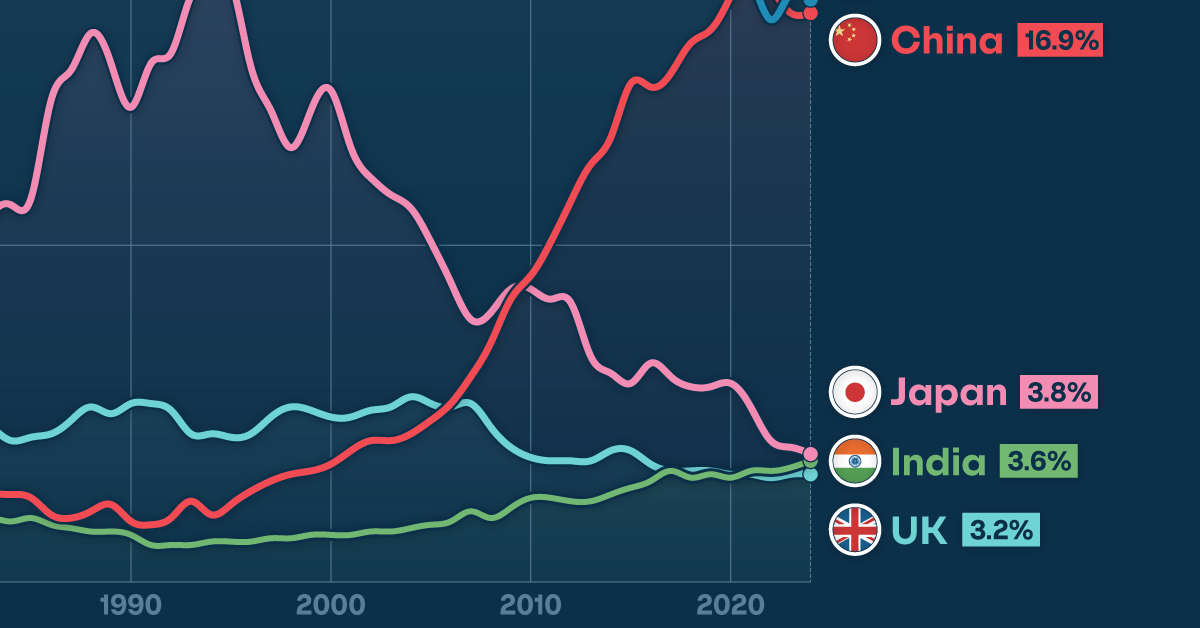
Top 6 Economies by Share of Global GDP (1980-2024)
This was originally posted on our Voronoi app. Download the app for free on iOS or Android and discover incredible data-driven charts from a variety of trusted sources.
Over time, the distribution of global GDP among the world’s largest economies has shifted dynamically, reflecting changes in economic policies, technological advancements, and demographic trends.
To see how this has played out in recent decades, we visualized the world’s top six economies by their share of global GDP from 1980 to 2024.
All figures were sourced from the IMF’s World Economic Outlook (April 2024 edition) and are based on using current prices.
Data and Highlights
The data we used to create this graphic can be found in the table below.
| Share of Global GDP (%) | U.S. | EU | China | Japan | UK | India |
|---|---|---|---|---|---|---|
| 1980 | 25.4% | 28.6% | 2.7% | 10.1% | 5.4% | 1.7% |
| 1981 | 27.8% | 24.7% | 2.5% | 10.8% | 5.1% | 1.7% |
| 1982 | 29.6% | 24.4% | 2.5% | 10.2% | 4.9% | 1.8% |
| 1983 | 31.3% | 23.2% | 2.6% | 10.9% | 4.6% | 1.9% |
| 1984 | 33.6% | 21.6% | 2.6% | 11.2% | 4.2% | 1.8% |
| 1985 | 34.6% | 21.3% | 2.5% | 11.4% | 4.3% | 1.9% |
| 1986 | 31.0% | 24.7% | 2.0% | 14.3% | 4.4% | 1.7% |
| 1987 | 28.5% | 26.3% | 1.9% | 15.2% | 4.8% | 1.6% |
| 1988 | 27.3% | 25.9% | 2.1% | 16.3% | 5.2% | 1.5% |
| 1989 | 28.0% | 25.0% | 2.3% | 15.4% | 5.0% | 1.5% |
| 1990 | 26.3% | 27.4% | 1.8% | 14.1% | 5.3% | 1.4% |
| 1991 | 26.0% | 28.0% | 1.7% | 15.4% | 5.3% | 1.1% |
| 1992 | 25.7% | 28.8% | 1.9% | 15.7% | 5.1% | 1.1% |
| 1993 | 26.3% | 25.6% | 2.4% | 17.4% | 4.4% | 1.1% |
| 1994 | 26.0% | 25.3% | 2.0% | 17.8% | 4.4% | 1.2% |
| 1995 | 24.5% | 26.5% | 2.3% | 17.8% | 4.3% | 1.2% |
| 1996 | 25.1% | 26.2% | 2.7% | 15.3% | 4.4% | 1.2% |
| 1997 | 26.8% | 24.1% | 3.0% | 14.0% | 4.9% | 1.3% |
| 1998 | 28.4% | 25.0% | 3.2% | 12.9% | 5.2% | 1.3% |
| 1999 | 29.2% | 24.0% | 3.3% | 14.0% | 5.1% | 1.4% |
| 2000 | 30.1% | 21.3% | 3.5% | 14.6% | 4.9% | 1.4% |
| 2001 | 31.3% | 21.8% | 3.9% | 12.9% | 4.9% | 1.4% |
| 2002 | 31.3% | 23.1% | 4.2% | 12.0% | 5.1% | 1.5% |
| 2003 | 29.2% | 25.3% | 4.2% | 11.5% | 5.2% | 1.5% |
| 2004 | 27.7% | 25.8% | 4.4% | 11.1% | 5.5% | 1.6% |
| 2005 | 27.2% | 24.9% | 4.8% | 10.1% | 5.3% | 1.7% |
| 2006 | 26.7% | 24.5% | 5.3% | 8.9% | 5.2% | 1.8% |
| 2007 | 24.7% | 25.2% | 6.1% | 7.8% | 5.3% | 2.1% |
| 2008 | 23.0% | 25.4% | 7.1% | 8.0% | 4.6% | 1.9% |
| 2009 | 23.8% | 24.3% | 8.4% | 8.7% | 4.0% | 2.2% |
| 2010 | 22.6% | 21.9% | 9.1% | 8.7% | 3.7% | 2.5% |
| 2011 | 21.1% | 21.3% | 10.1% | 8.4% | 3.6% | 2.5% |
| 2012 | 21.6% | 19.5% | 11.3% | 8.3% | 3.6% | 2.4% |
| 2013 | 21.8% | 19.7% | 12.4% | 6.7% | 3.6% | 2.4% |
| 2014 | 22.1% | 19.7% | 13.2% | 6.2% | 3.9% | 2.6% |
| 2015 | 24.4% | 18.0% | 14.8% | 5.9% | 3.9% | 2.8% |
| 2016 | 24.6% | 18.2% | 14.7% | 6.5% | 3.5% | 3.0% |
| 2017 | 24.1% | 18.2% | 15.1% | 6.1% | 3.3% | 3.3% |
| 2018 | 24.0% | 18.5% | 16.0% | 5.8% | 3.3% | 3.1% |
| 2019 | 24.6% | 17.9% | 16.4% | 5.8% | 3.3% | 3.2% |
| 2020 | 25.0% | 18.0% | 17.4% | 5.9% | 3.2% | 3.1% |
| 2021 | 24.3% | 17.9% | 18.3% | 5.2% | 3.2% | 3.3% |
| 2022 | 25.6% | 16.7% | 17.7% | 4.2% | 3.1% | 3.3% |
| 2023 | 26.1% | 17.5% | 16.9% | 4.0% | 3.2% | 3.4% |
| 2024E | 26.3% | 17.3% | 16.9% | 3.8% | 3.2% | 3.6% |
U.S. Resilience
Starting with the U.S., we can see that America’s share of global GDP has fluctuated quite significantly over time.
After bottoming out at 21.1% in 2011, the U.S. economy grew its relative size by several percentage points, and is estimated by the IMF to make up 26.3% of global GDP in 2024.
This chart also suggests that the U.S. has managed a stronger recovery from the COVID-19 pandemic, evidenced by its rising share of global GDP since 2020. China, the EU, and Japan have seen relative declines over the same period.
China’s Incredible Rise
This chart also provides perspective on China’s period of rapid economic growth, which began in the early 2000s.
It’s interesting to note that China joined the World Trade Organization (WTO) in 2001, which facilitated China’s integration into the global economy.
Japan Falls From the #2 Spot
Japan was once the second largest country economy after the U.S., accounting for 17.8% of the global economy in 1994 and 1995. Since then, economic stagnation and an aging population have resulted in a relative decline of the country’s economic might.
See More Global Economic Insights From Visual Capitalist
If you enjoyed this post, be sure to check out Ranked: The Top Economies in the World (1980-2075), which shows how China and India could eventually surpass the U.S. as the world’s biggest economies.
-

 Personal Finance6 days ago
Personal Finance6 days agoVisualizing the Tax Burden of Every U.S. State
-

 Economy2 weeks ago
Economy2 weeks agoThe Most Valuable Companies in Major EU Economies
-

 Markets2 weeks ago
Markets2 weeks agoThe World’s Fastest Growing Emerging Markets (2024-2029 Forecast)
-

 Markets2 weeks ago
Markets2 weeks agoVisualizing Global Inflation Forecasts (2024-2026)
-

 Politics2 weeks ago
Politics2 weeks agoCharted: What Southeast Asia Thinks About China & the U.S.
-

 Misc1 week ago
Misc1 week agoThe Evolution of U.S. Beer Logos
-

 Healthcare1 week ago
Healthcare1 week agoWhat Causes Preventable Child Deaths?
-

 Energy1 week ago
Energy1 week agoWho’s Building the Most Solar Energy?




